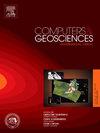A high-efficiency parallel fast marching method for large-scale seismic tomography in three-dimensional spherical coordinates
IF 4.2
2区 地球科学
Q1 COMPUTER SCIENCE, INTERDISCIPLINARY APPLICATIONS
引用次数: 0
Abstract
The fast marching method is an essential step in the level set method, widely applied in seismic tomography. However, there are two key challenges in large-scale seismic tomography: significant time consumption and storage issues related to large-scale matrices. Therefore, it is crucial to develop a high-efficiency and high-accuracy parallel fast marching method. Although previous scholars have developed parallel fast marching algorithms based on various parallel strategies in Cartesian coordinates, these algorithms ignore the influence of the Earth’s curvature and generally achieve only first-order accuracy. To address these problems, this study introduces a distributed-memory parallel fast marching method based on domain decomposition to solve the eikonal equation in 3D spherical coordinates. By introducing spherical coordinates, the method naturally accounts for the Earth’s curvature. Additionally, this study designs a parallel strategy based on a second-order scheme and uses the multiplicative factorization technique to handle point source singularities. The parallel strategy ensures the global causality condition of the traveltime field and maintains global second-order accuracy. Numerical experiments show that the parallel algorithm can solve the factor eikonal equation for 8.5 billion grid points or greater. It distributes the over 200 GB memory requirement per node in sequential FMM across multiple nodes, significantly reducing computation time and memory needs while maintaining second-order accuracy. Furthermore, the algorithm proves to be suitable for earthquake location applications. This highly efficient and accurate parallel algorithm is applicable for large-scale seismic tomography and other related research.
三维球坐标下大规模地震层析成像的一种高效并行快速推进方法
快速推进法是水平集法的关键步骤,在地震层析成像中得到了广泛的应用。然而,大规模地震层析成像存在两个关键挑战:与大规模矩阵相关的大量时间消耗和存储问题。因此,开发一种高效、高精度的并行快速行军方法至关重要。虽然已有学者基于笛卡尔坐标下的各种并行策略开发了并行快速行军算法,但这些算法忽略了地球曲率的影响,一般只能达到一阶精度。为了解决这些问题,本研究提出了一种基于区域分解的分布式存储并行快速推进方法来求解三维球坐标中的eikonal方程。通过引入球坐标,这种方法自然地解释了地球的曲率。此外,本研究还设计了一种基于二阶格式的并行策略,并使用乘法分解技术来处理点源奇点。并行策略保证了行时域的全局因果性条件,并保持了全局二阶精度。数值实验表明,该并行算法可以求解85亿个网格点以上的因子对偶方程。它在顺序FMM中跨多个节点分配每个节点超过200 GB的内存需求,在保持二阶精度的同时显著减少了计算时间和内存需求。结果表明,该算法适用于地震定位。这种高效、精确的并行算法适用于大规模地震层析成像等相关研究。
本文章由计算机程序翻译,如有差异,请以英文原文为准。
求助全文
约1分钟内获得全文
求助全文
来源期刊

Computers & Geosciences
地学-地球科学综合
CiteScore
9.30
自引率
6.80%
发文量
164
审稿时长
3.4 months
期刊介绍:
Computers & Geosciences publishes high impact, original research at the interface between Computer Sciences and Geosciences. Publications should apply modern computer science paradigms, whether computational or informatics-based, to address problems in the geosciences.
 求助内容:
求助内容: 应助结果提醒方式:
应助结果提醒方式:


